The global fuel rail for CNG systems market is valued at USD 554.7 million in 2025 and is set to reach USD 1,111.7 million by 2035, recording an absolute increase of USD 557 million over the forecast period. This translates into a total growth of 100.4%, with the market forecast to expand at a compound annual growth rate (CAGR) of 7.2% between 2025 and 2035. The overall market size is expected to grow by approximately 2.0X during the same period, supported by increasing adoption of compressed natural gas vehicles, growing government initiatives promoting cleaner fuel alternatives, and rising demand for efficient fuel delivery systems across automotive, commercial vehicle, and marine transportation sectors.
The global fuel rail for CNG systems market represents a crucial component within the alternative fuel vehicle industry, driven by increasing environmental consciousness and stringent emission regulations across major automotive markets. CNG fuel rails serve as critical components in compressed natural gas fuel systems, responsible for distributing pressurized gas to individual fuel injectors with precise timing and pressure control. The market encompasses sophisticated engineering solutions that ensure optimal fuel delivery performance, enhanced system reliability, and compliance with rigorous safety standards required for high-pressure gas applications.
The market includes various technological configurations designed to meet diverse vehicle requirements, ranging from sequential injection rails that provide individual cylinder fuel control to simultaneous injection systems optimized for specific engine applications. Modern CNG fuel rails incorporate advanced materials engineering, precision manufacturing processes, and integrated pressure management systems that can withstand the demanding operational conditions associated with compressed natural gas fuel delivery. The integration of electronic control systems, pressure sensors, and safety monitoring technologies has significantly enhanced the performance and reliability of these specialized fuel delivery components.
Market dynamics are significantly influenced by global initiatives promoting alternative fuel adoption, particularly in commercial transportation and public transit applications where CNG offers substantial operational cost advantages and emission reduction benefits. The automotive industry's transition toward cleaner fuel technologies, combined with expanding CNG refueling infrastructure development, has created substantial demand for high-performance fuel rail systems in passenger vehicles, commercial trucks, buses, and specialized transportation equipment. The growing emphasis on energy independence and reduced fossil fuel consumption has amplified the adoption of CNG technologies across diverse transportation applications.
Consumer and fleet operator preferences show increasing demand for fuel rail systems that combine exceptional pressure management capabilities with enhanced durability characteristics, including corrosion resistance, temperature stability, and long-term operational reliability. The market has witnessed significant technological advancement in materials science, precision manufacturing techniques, and integrated safety systems, making these components more suitable for demanding commercial applications and extended service intervals across various vehicle platforms and operating environments.
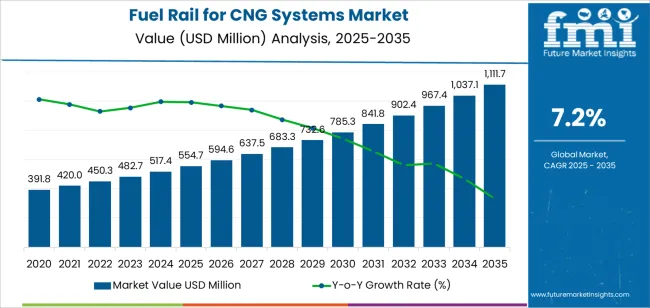
Between 2025 and 2030, the fuel rail for CNG systems market is projected to expand from USD 554.7 million to USD 785.2 million, resulting in a value increase of USD 230.5 million, which represents 41.4% of the total forecast growth for the decade. This phase of development will be shaped by increasing adoption of CNG commercial vehicles, expanding natural gas vehicle infrastructure, and growing availability of advanced fuel delivery systems across automotive manufacturing facilities and specialized transportation applications.
Between 2030 and 2035, the market is forecast to grow from USD 785.2 million to USD 1,111.7 million, adding another USD 326.5 million, which constitutes 58.6% of the overall ten-year expansion. This period is expected to be characterized by the advancement of electronically controlled fuel delivery systems, the development of integrated pressure management technologies for high-performance applications, and the expansion of precision-engineered fuel rail components across diverse commercial and industrial transportation platforms. The growing emphasis on operational efficiency and environmental compliance will drive demand for advanced CNG fuel rail varieties with enhanced pressure control capabilities, improved material durability characteristics, and superior safety monitoring performance profiles.
Between 2020 and 2024, the fuel rail for CNG systems market experienced accelerated growth, driven by increasing adoption of natural gas vehicles and growing recognition of CNG technology advantages in commercial transportation applications following extensive fleet modernization programs. The market developed as automotive manufacturers and fleet operators recognized the potential for advanced fuel rail systems to deliver performance advantages while meeting modern requirements for emission reduction and operational cost optimization. Technological advancement in pressure control engineering and materials science began emphasizing the critical importance of maintaining fuel delivery precision while enhancing component durability and improving system reliability across diverse automotive and commercial vehicle applications.
| Metric | Value |
|---|---|
| Estimated Value in (2025E) | USD 554.7 million |
| Forecast Value in (2035F) | USD 1,111.7 million |
| Forecast CAGR (2025 to 2035) | 7.2% |
From 2030 to 2035, the market is forecast to grow from USD 785.2 million to USD 1,111.7 million, adding another USD 326.5 million, which constitutes 58.6% of the overall ten-year expansion. This period is expected to be characterized by the advancement of intelligent fuel management integration in vehicle control systems, the integration of predictive maintenance capabilities for optimal component replacement scheduling, and the development of specialized fuel rail configurations for high-capacity commercial vehicle applications. The growing emphasis on fleet efficiency optimization and environmental performance will drive demand for premium varieties with enhanced electronic integration capabilities, improved pressure monitoring options, and superior automated operation characteristics.
Between 2020 and 2024, the fuel rail for CNG systems market experienced robust growth, driven by increasing awareness of alternative fuel vehicle benefits and growing recognition of specialized fuel delivery systems' effectiveness in supporting efficient CNG vehicle operations across commercial fleet facilities and public transportation services. The market developed as users recognized the potential for advanced fuel rail solutions to deliver operational advantages while meeting modern requirements for comprehensive vehicle performance monitoring and reliable fuel system operation. Technological advancement in precision fuel delivery processes and pressure management systems began emphasizing the critical importance of maintaining injection accuracy while extending component service life and improving user satisfaction across diverse CNG vehicle applications.
Market expansion is being supported by the increasing global adoption of compressed natural gas vehicles and the corresponding shift toward high-performance specialized fuel delivery systems that can provide superior pressure management characteristics while meeting user requirements for comprehensive vehicle performance and cost-effective transportation solutions. Modern fleet operators and automotive manufacturers are increasingly focused on incorporating fuel rail systems that can enhance vehicle efficiency while satisfying demands for consistent, precisely controlled fuel delivery and optimized operational cost practices. CNG fuel rails' proven ability to deliver targeted injection excellence, vehicle performance improvement, and diverse application possibilities makes them essential components for environmentally conscious fleet operators and quality-focused automotive professionals.
The growing emphasis on alternative fuel adoption and transportation emission optimization is driving demand for high-performance fuel rail systems that can support distinctive efficiency outcomes and comprehensive vehicle management across commercial transportation projects, fleet modernization applications, and premium automotive developments. User preference for fuel delivery systems that combine functional excellence with environmental benefits is creating opportunities for innovative implementations in both traditional and emerging automotive applications. The rising influence of government emission regulations and advanced vehicle control technologies is also contributing to increased adoption of specialized CNG fuel rail solutions that can provide authentic performance benefits and reliable fuel system monitoring characteristics.
The market is segmented by type, application, capacity, materials, and region. By type, the market is divided into sequential injection rail, simultaneous injection rail, and others. Based on application, the market is categorized into automobile, commercial vehicle, marine vessel, industrial equipment, and others. By capacity, the market includes small capacity (up to 3L), medium capacity (3.1L-6L), large capacity (6.1L-12L), and high capacity (above 12L). By materials, the market encompasses stainless steel construction, aluminum alloy construction, composite materials, and hybrid material systems. Regionally, the market is divided into North America, Europe, Asia Pacific, Latin America, Middle East & Africa, and other regions.
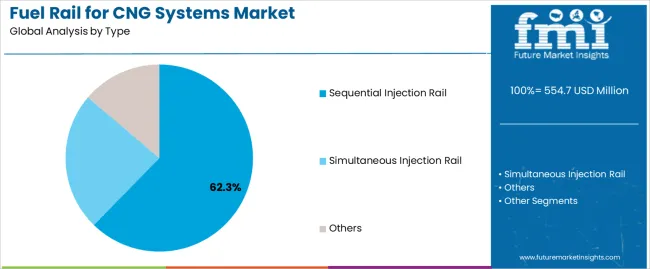
The sequential injection rail segment is projected to account for 62.3% of the fuel rail for CNG systems market in 2025, reaffirming its position as the leading type category. Automotive manufacturers and fleet operators increasingly utilize sequential injection systems for their superior fuel distribution characteristics, established performance standards, and essential functionality in diverse vehicle applications across multiple transportation categories. Sequential injection rails' proven performance characteristics and established cost-effectiveness directly address user requirements for precise fuel delivery and optimal engine performance in passenger vehicle and commercial applications.
This type segment forms the foundation of modern CNG fuel delivery performance patterns, as it represents the technology category with the greatest injection control potential and established compatibility across multiple vehicle management systems. Automotive investments in advanced injection technology and performance optimization continue to strengthen adoption among efficiency-focused operators. With manufacturers prioritizing fuel delivery consistency and system reliability, sequential injection systems align with both performance objectives and operational requirements, making them the central component of comprehensive CNG vehicle strategies.
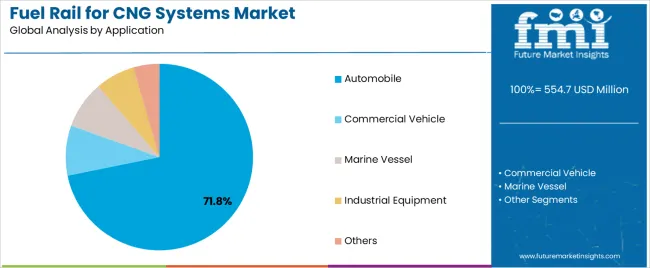
Automobile is projected to represent 71.8% of the fuel rail for CNG systems market in 2025, underscoring its critical role as the primary application for environmentally conscious consumers seeking superior vehicle efficiency benefits and enhanced automotive performance management credentials. Automotive manufacturers and vehicle owners prefer automobile applications for their established emission reduction requirements, proven consumer demand, and ability to maintain exceptional fuel efficiency while supporting versatile driving conditions during diverse transportation activities. Positioned as essential applications for environmentally conscious consumers, automobile offerings provide both performance excellence and environmental protection advantages.
The segment is supported by continuous improvement in vehicle control technology and the widespread availability of established emission standards that enable performance assurance and premium positioning at the consumer level. Automotive manufacturers are optimizing fuel rail selections to support engine-specific applications and comprehensive vehicle efficiency strategies. As automotive technology continues to advance and consumers seek efficient transportation methods, automobile applications will continue to drive market growth while supporting vehicle efficiency and environmental performance strategies.
The fuel rail for CNG systems market is advancing rapidly due to increasing environmental awareness regarding vehicle emissions and growing need for specialized fuel delivery solutions that emphasize superior injection performance across automotive segments and commercial applications. The market faces challenges, including competition from alternative fuel technologies, infrastructure development requirements, and initial conversion cost considerations affecting adoption rates. Innovation in electronic control integration and advanced materials engineering continues to influence market development and expansion patterns.
The growing adoption of fuel rail systems with electronic control integration and advanced monitoring capabilities is enabling fleet operators to develop fuel management strategies that provide distinctive efficiency benefits while commanding automated operation and enhanced real-time performance analysis characteristics. Electronic applications provide superior control consistency while allowing more sophisticated fuel delivery optimization features across various vehicle categories. Users are increasingly recognizing the operational advantages of electronic integration positioning for comprehensive vehicle performance outcomes and technology-integrated transportation management.
Modern fuel rail manufacturers are incorporating advanced pressure sensors, real-time monitoring capabilities, and automated safety systems to enhance fuel delivery precision, improve operational effectiveness, and meet consumer demands for intelligent vehicle management solutions. These systems improve operational effectiveness while enabling new applications, including continuous fuel system monitoring programs and predictive maintenance protocols. Advanced pressure management integration also allows operators to support proactive vehicle maintenance positioning and performance assurance beyond traditional fuel delivery operations.
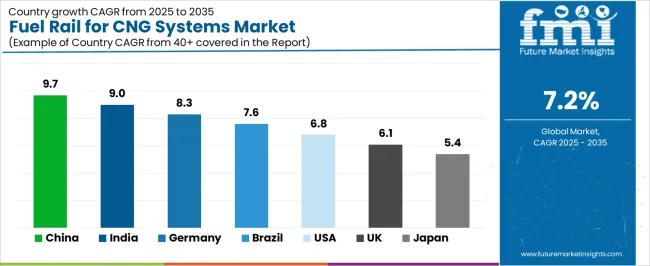
| Country | CAGR (2025 to 2035) |
|---|---|
| China | 9.7% |
| India | 9% |
| Germany | 8.3% |
| Brazil | 7.6% |
| USA | 6.8% |
| UK | 6.1% |
| Japan | 5.4% |
The fuel rail for CNG systems market is experiencing robust growth globally, with China leading at a 9.7% CAGR through 2035, driven by the expanding natural gas vehicle adoption, growing environmental awareness requirements, and increasing implementation of advanced fuel delivery systems. India follows at 9%, supported by rising commercial vehicle electrification alternatives, expanding fleet modernization programs, and growing acceptance of alternative fuel technologies. Germany shows growth at 8.3%, emphasizing established emission standards and comprehensive automotive technology development. Brazil records 7.6%, focusing on commercial transportation modernization and environmental consciousness growth. The USA demonstrates 6.8% growth, prioritizing advanced vehicle technologies and emission optimization.
The report covers an in-depth analysis of 40+ countries, top-performing countries are highlighted below.
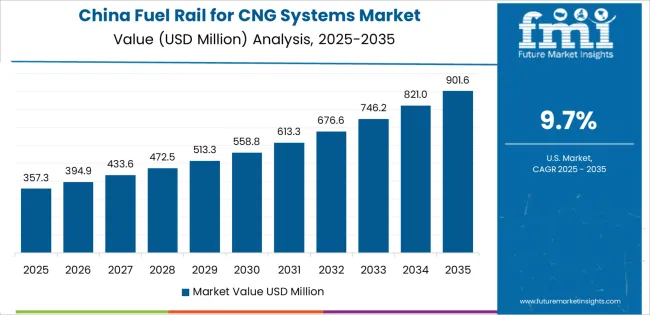
Revenue from fuel rail for CNG systems consumption and sales in China is projected to exhibit exceptional growth with a CAGR of 9.7% through 2035, driven by the country's rapidly expanding natural gas vehicle sector, favorable government policies toward alternative fuel adoption, and initiatives promoting environmental transportation technologies across major industrial regions. China's position as a leading automotive manufacturing hub and increasing focus on emission reduction systems are creating substantial demand for high-quality CNG fuel rails in both domestic and export markets. Major automotive companies and fuel system distributors are establishing comprehensive manufacturing capabilities to serve growing demand and emerging environmental consciousness opportunities.
Revenue from fuel rail for CNG systems products in India is expanding at a CAGR of 9%, supported by rising commercial vehicle modernization investment, growing environmental consciousness, and expanding automotive distributor capabilities. The country's developing transportation infrastructure and increasing fleet investment in alternative fuel technologies are driving demand for CNG fuel rails across both traditional and modern commercial applications. International automotive companies and domestic distributors are establishing comprehensive operational networks to address growing market demand for emission reduction devices and efficient fuel delivery solutions.
Revenue from fuel rail for CNG systems products in Germany is projected to grow at a CAGR of 8.3% through 2035, supported by the country's mature automotive standards, established emission regulations, and leadership in automotive technology. Germany's sophisticated vehicle standards and strong support for advanced fuel systems are creating steady demand for both traditional and innovative CNG fuel rail varieties. Leading automotive manufacturers and specialty distributors are establishing comprehensive operational strategies to serve both domestic markets and growing export opportunities.
Revenue from fuel rail for CNG systems products in Brazil is projected to grow at a CAGR of 7.6% through 2035, driven by the country's emphasis on transportation development, environmental consciousness growth, and growing automotive distributor capabilities. Brazilian fleet operators and commercial users consistently seek efficiency-focused fuel systems that enhance vehicle performance and support environmental excellence for both traditional and modern transportation applications. The country's position as a Latin American automotive market leader continues to drive innovation in specialized fuel delivery applications and commercial vehicle performance standards.
Revenue from fuel rail for CNG systems products in the USA is projected to grow at a CAGR of 6.8% through 2035, supported by the country's emphasis on automotive technology advancement, vehicle efficiency optimization, and advanced control integration requiring efficient fuel delivery solutions. American fleet operators and efficiency-focused users prioritize performance reliability and emission reduction precision, making specialized CNG fuel rails essential components for both traditional and modern automotive applications. The country's comprehensive automotive technology leadership and advancing efficiency patterns support continued market expansion.
Revenue from fuel rail for CNG systems products in the UK is projected to grow at a CAGR of 6.1% through 2035, supported by established environmental protection standards, mature automotive markets, and emphasis on fuel efficiency reliability across transportation and commercial sectors. British fleet operators and efficiency-focused professionals prioritize quality performance and environmental consistency, creating steady demand for premium fuel delivery solutions. The country's comprehensive market maturity and established environmental protection practices support continued development in specialized applications.
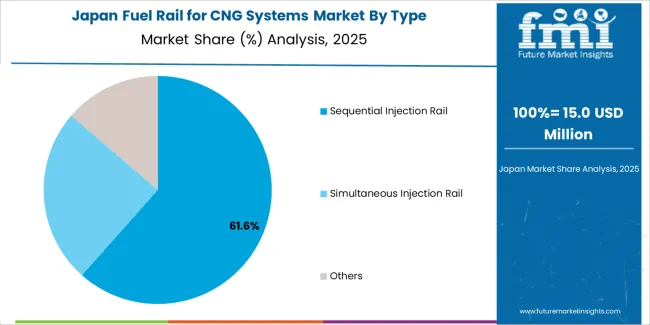
Revenue from fuel rail for CNG systems products in Japan is projected to grow at a CAGR of 5.4% through 2035, supported by the country's emphasis on precision manufacturing, automotive excellence, and advanced technology integration requiring efficient fuel delivery solutions. Japanese automotive manufacturers and efficiency-focused users prioritize technical performance and manufacturing precision, making specialized CNG fuel rails essential components for both traditional and modern vehicle applications. The country's comprehensive automotive leadership and advancing efficiency patterns support continued market expansion.
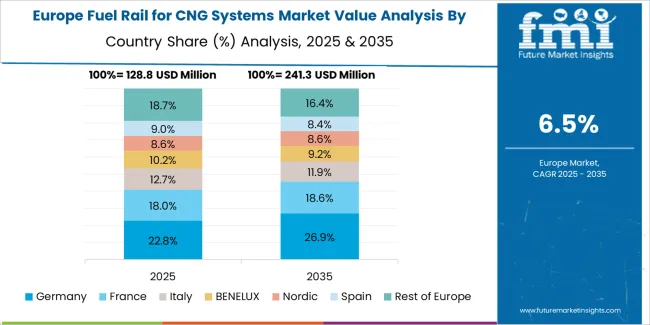
The Europe fuel rail for CNG systems market is projected to grow from USD 163.2 million in 2025 to USD 327.4 million by 2035, recording a CAGR of 7.2% over the forecast period. Germany leads the region with a 43.8% share in 2025, moderating slightly to 42.6% by 2035, supported by its strong automotive manufacturing base and demand for premium, technologically advanced fuel delivery solutions.
The United Kingdom follows with 22.7% in 2025, easing to 22.1% by 2035, driven by a mature efficiency-conscious fleet market and emphasis on emission reduction reliability and environmental performance. France accounts for 14.2% in 2025, rising to 15.1% by 2035, reflecting steady adoption of environmental technologies and efficiency enhancement. Italy holds 8.9% in 2025, expanding to 9.8% by 2035 as environmental consciousness and specialty automotive applications grow.
Spain contributes 6.1% in 2025, growing to 6.7% by 2035, supported by expanding commercial vehicle development and environmental awareness modernization. The Nordic countries rise from 3.2% in 2025 to 3.4% by 2035 on the back of strong environmental consciousness and advanced efficiency methodologies. BENELUX remains at 1.1% share across both 2025 and 2035, reflecting mature, efficiency-focused automotive markets.
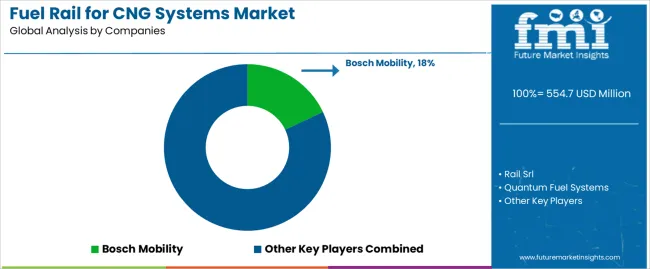
The fuel rail for CNG systems market is characterized by competition among established automotive component manufacturers, specialized fuel system companies, and integrated vehicle technology providers. Companies are investing in advanced materials engineering, specialized pressure management systems, product innovation capabilities, and comprehensive distribution networks to deliver consistent, high-quality, and reliable CNG fuel rail systems. Innovation in pressure control accuracy, materials durability optimization, and efficiency-focused product development is central to strengthening market position and customer satisfaction.
Bosch Mobility leads the market with 18% share with a strong focus on automotive technology innovation and comprehensive fuel delivery solutions, offering passenger vehicle and commercial systems with emphasis on performance excellence and engineering heritage. Rail Srl provides specialized fuel rail manufacturing with a focus on European market applications and precision engineering networks. Quantum Fuel Systems delivers integrated alternative fuel solutions with a focus on commercial positioning and operational efficiency. Sazeh Pouyesh specializes in comprehensive CNG system components with an emphasis on regional market applications. Motozen CNG focuses on comprehensive automotive fuel systems with advanced design and premium positioning capabilities.
The success of fuel rail for CNG systems in meeting automotive efficiency demands, transportation emission requirements, and environmental integration will not only enhance vehicle performance outcomes but also strengthen global automotive technology manufacturing capabilities. It will consolidate emerging regions' positions as hubs for efficient automotive component production and align advanced economies with comprehensive environmental systems. This calls for a concerted effort by all stakeholders -- governments, industry bodies, manufacturers, distributors, and investors. Each can be a crucial enabler in preparing the market for its next phase of growth.
| Items | Values |
|---|---|
| Quantitative Units (2025) | USD 554.7 million |
| Type | Sequential Injection Rail, Simultaneous Injection Rail, Others |
| Application | Automobile, Commercial Vehicle, Marine Vessel, Industrial Equipment, Others |
| Capacity | Small Capacity (up to 3L), Medium Capacity (3.1L-6L), Large Capacity (6.1L-12L), High Capacity (above 12L) |
| Materials | Stainless Steel Construction, Aluminum Alloy Construction, Composite Materials, Hybrid Material Systems |
| Regions Covered | North America, Europe, Asia Pacific, Latin America, Middle East & Africa, Other Regions |
| Countries Covered | China, India, Germany, Brazil, United States, United Kingdom, Japan, and 40+ countries |
| Key Companies Profiled | Bosch Mobility, Rail Srl, Quantum Fuel Systems, Sazeh Pouyesh, Motozen CNG, and other leading fuel rail for CNG systems companies |
| Additional Attributes | Dollar sales by type, application, capacity, materials, and region; regional demand trends, competitive landscape, technological advancements in fuel delivery engineering, precision injection initiatives, environmental protection enhancement programs, and premium product development strategies |
The global fuel rail for CNG systems market is estimated to be valued at USD 554.7 million in 2025.
The market size for the fuel rail for CNG systems market is projected to reach USD 1,111.7 million by 2035.
The fuel rail for CNG systems market is expected to grow at a 7.2% CAGR between 2025 and 2035.
The key product types in fuel rail for CNG systems market are sequential injection rail, simultaneous injection rail and others.
In terms of application, automobile segment to command 71.8% share in the fuel rail for CNG systems market in 2025.






Full Research Suite comprises of:
Market outlook & trends analysis
Interviews & case studies
Strategic recommendations
Vendor profiles & capabilities analysis
5-year forecasts
8 regions and 60+ country-level data splits
Market segment data splits
12 months of continuous data updates
DELIVERED AS:
PDF EXCEL ONLINE
Fuel Storage Tank Market Size and Share Forecast Outlook 2025 to 2035
Fuel Capacitance Test Equipment Market Size and Share Forecast Outlook 2025 to 2035
Fuel Gas Heater Market Size and Share Forecast Outlook 2025 to 2035
Fuel Management Software Market Size and Share Forecast Outlook 2025 to 2035
Fuel Cell Powertrain Market Size and Share Forecast Outlook 2025 to 2035
Fuel Cell UAV Market Size and Share Forecast Outlook 2025 to 2035
Fuel Cell Stack Market Size and Share Forecast Outlook 2025 to 2035
Fuel Cell Electric Vehicle Market Size and Share Forecast Outlook 2025 to 2035
Fuel Cell Commercial Vehicle Market Size and Share Forecast Outlook 2025 to 2035
Fuel Injection System Market Growth - Trends & Forecast 2025 to 2035
Fuel Additives Market Segmentation based on Type, Application, and Region: Forecast for 2025 and 2035
Fuel Cell Market Growth – Trends & Forecast 2025 to 2035
Fuel Analyzer Market
Fuel Vending Machines Market
Fuel Operated Heaters Market
Fuel Resistant Sealant Market
Fuel Feed Pumps Market
Fuel Measuring Devices Market
Fuel Cell for Data Center Market - Trends & Forecast 2025 to 2035
Fuel Cell for Stationary Power Market Growth - Trends & Forecast 2025 to 2035

Thank you!
You will receive an email from our Business Development Manager. Please be sure to check your SPAM/JUNK folder too.
Chat With
MaRIA